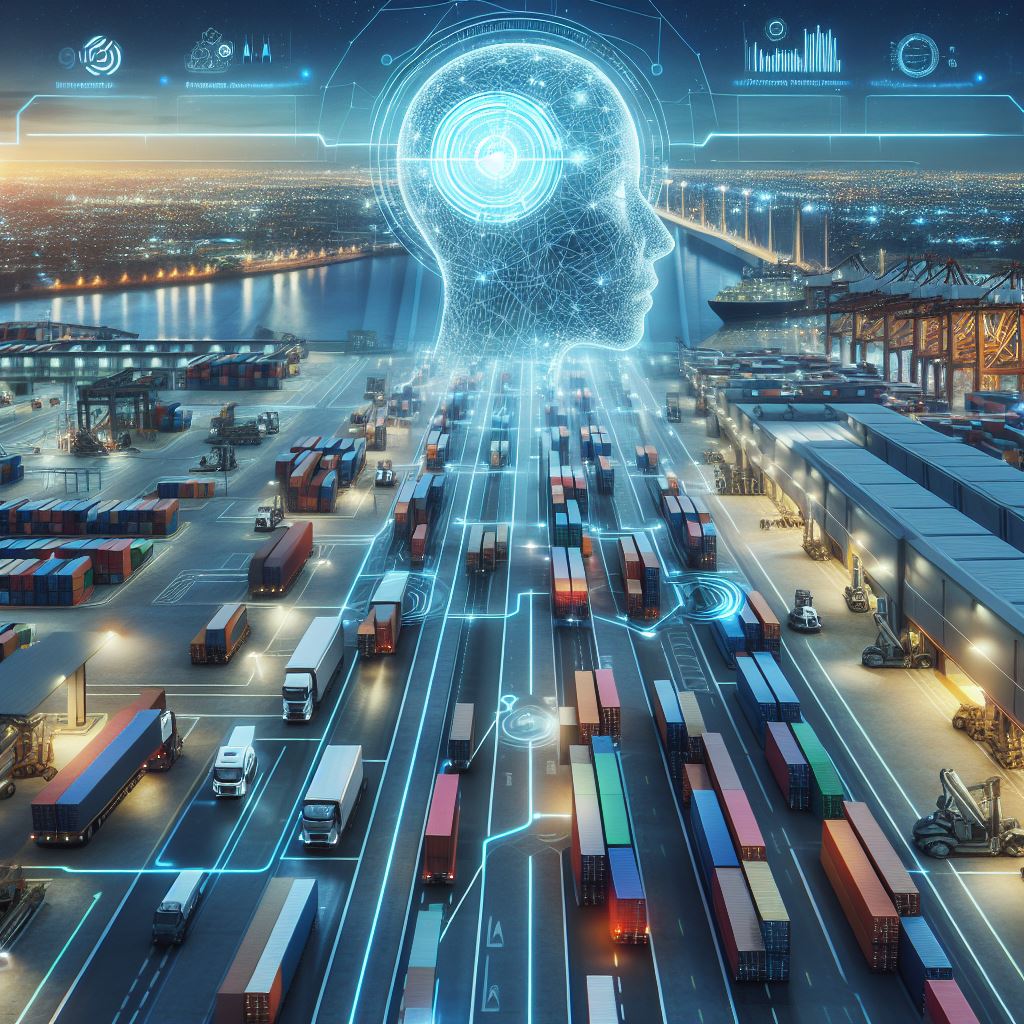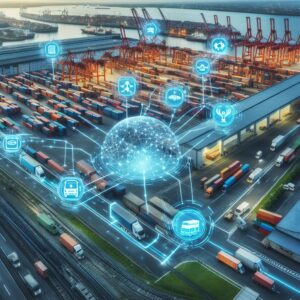Yard Management Reimagined: 5 Ways AI is Transforming Logistics
Have you ever been stuck behind a truck in a crowded parking lot, wasting precious minutes searching for an empty spot? Now imagine that frustration multiplied by a thousand, playing out in a busy logistics yard. Trucks jockey for position, trailers wait to be unloaded, and valuable time ticks by. But what if there was a smarter way?
Enter Artificial Intelligence (AI). This powerful technology is rapidly transforming the world of logistics, and yard management is no exception. By leveraging AI’s analytical prowess and real-time data processing, logistics companies are reimagining their yards, optimizing space, streamlining operations, and saving big. In this blog post, we’ll dive into 5 fascinating ways AI is transforming yard management, making the logistics landscape faster, more efficient, and a whole lot less like that chaotic parking lot.
The Pain Points of Traditional Yard Management
Traditional yard management practices often encounter several pain points that hinder operational efficiency and effectiveness. These pain points primarily stem from the manual and outdated processes that fail to keep pace with the demands of modern logistics. Let’s explore some of the key pain points associated with traditional yard management:
Inefficient Use of Space
In traditional yard management, one of the significant challenges is the inefficient use of available space. Without proper planning and optimization, yards often suffer from congestion, clutter, and wasted capacity. This inefficiency arises due to:
- Difficulty in Locating Trailers: Without a centralized tracking system, yard personnel often struggle to locate specific trailers amidst a sea of vehicles. This leads to wasted time and effort as they navigate the yard in search of the required trailer.
- Underutilized Yard Capacity: Inefficient layout designs and poor space utilization cause underutilized yard capacity. Some areas may remain vacant or unused, while others become overcrowded, leading to imbalances in resource allocation and decreased overall throughput.
Delays in Loading and Unloading
Another common pain point in traditional yard management is the occurrence of delays during the loading and unloading processes. These delays can be attributed to:
- Long Wait Times for Trucks: Trucks arriving at the yard often face long wait times before they can be assigned a dock door or designated parking spot. This delay not only impacts the efficiency of the yard but also disrupts the schedules of truck drivers and carriers, leading to dissatisfaction and potential penalties.
- Unclear Communication and Scheduling: Communication breakdowns between yard personnel, drivers, and internal stakeholders can lead to confusion and delays in coordinating loading and unloading activities. Problems arise from unclear instructions, outdated scheduling methods, and excessive manual paperwork. A recent State of Yard Management Overview highlights that 46% of surveyed respondents identified reducing paperwork as one of their top three major challenges.
Lack of Visibility and Control
Traditional yard management practices typically rely on manual tracking methods and paper-based processes, leading to limited visibility and control over yard operations. Key pain points in this regard include:
- Manual Tracking of Trailers: Yard personnel often resort to manual methods such as spreadsheets or paper logs to track the movement and status of trailers within the yard. This manual approach is prone to errors, delays, and inaccuracies, making it challenging to maintain real-time visibility over yard assets.
- Difficulty in Monitoring Yard Activity: Without automated monitoring systems, gaining insights into yard activity and performance becomes a daunting task. Yard managers struggle to track key metrics such as dwell times, asset utilization rates, and operational bottlenecks, limiting their ability to identify inefficiencies and implement timely corrective actions.
5 Ways AI is Transforming Yard Management
AI is transforming yard management practices in the logistics industry, offering innovative solutions to traditional challenges and driving efficiency, visibility, and control. Here are five key ways AI is transforming yard management:
-
AI-powered Yard Optimization
AI-powered yard optimization is altering the face of modern logistics by intelligently analyzing data to enhance trailer placement within yards. Through sophisticated algorithms, AI processes a myriad of factors including historical data on trailer movements, current inventory levels, and upcoming shipments, along with external variables like weather forecasts and traffic conditions.
By considering these variables, AI can strategically position trailers closer to loading docks or shipping lanes, thereby, reducing the time and distance for loading and unloading operations. This optimization not only minimizes congestion but also improves the overall flow of operations, leading to increased efficiency and productivity.
Real-time yard mapping and visualization tools play a crucial role in facilitating AI-powered optimization efforts. These tools provide dynamic updates and insights into yard layout and trailer locations, enabling yard managers to make informed decisions swiftly.
With interactive maps and color-coded indicators, managers can easily identify trailers that require attention and prioritize tasks accordingly. Additionally, predictive analytics integrated into these tools offer insights into future demand and potential bottlenecks, empowering managers to proactively adjust resources to prevent congestion and optimize capacity.
-
Predictive Analytics for Proactive Scheduling
AI harnesses the power of predictive analytics by analyzing vast amounts of historical data to forecast the arrival times of shipments. Through sophisticated algorithms, AI examines patterns and trends in past delivery schedules, considering factors such as traffic conditions, weather patterns, and historical shipping data. By identifying recurring patterns and anomalies, AI can accurately predict the arrival times of incoming shipments with a high degree of precision. This predictive capability enables logistics companies to anticipate when trucks will arrive at the yard, allowing for proactive scheduling of loading and unloading activities.
With AI-driven predictive analytics, logistics companies can proactively schedule loading and unloading tasks based on forecasted arrival times. By integrating predicted arrival times with existing schedules and resource availability, logistics managers can allocate resources more efficiently and optimize workflow planning. For example, if AI predicts that a shipment will arrive earlier than expected, managers can adjust staffing levels and equipment allocation accordingly, ensuring that resources are in place to handle the incoming workload. This proactive approach minimizes wait times for trucks and streamlines operations, leading to improved efficiency and productivity in the yard.
-
Automated Gate Management
AI-powered gate management systems improve truck arrivals and departures by automating and streamlining the entire process. These systems leverage AI technology to facilitate seamless entry and exit of trucks while ensuring security and efficiency. One key feature of AI-powered gates is license plate recognition, where cameras equipped with AI algorithms automatically capture and analyze license plate information as trucks approach the gate. This enables rapid and accurate identification of vehicles, eliminating the need for manual data entry and reducing the risk of errors associated with human input.
Once a truck’s license plate is recognized, AI-powered gate management systems facilitate automated check-in processes. Using pre-registered information or integrated databases, the system verifies the truck’s credentials, such as driver identification, vehicle registration, and shipment details. This automated verification process expedites check-in procedures, significantly reducing processing times and minimizing wait times for truck drivers. Furthermore, AI-powered gates can facilitate biometric authentication or RFID tag recognition for enhanced security and authentication, ensuring that only authorized vehicles gain access to the facility.
-
Real-time Tracking and Visibility
Imagine a yard where you can pinpoint the exact location of any trailer at any given moment. This isn’t science fiction; it’s the reality of AI-powered real-time tracking. AI acts as a tireless eye in the yard, leveraging a combination of technologies to provide a constantly updated picture of your assets. The foundation of this system lies in GPS integration. By equipping trailers with GPS devices, AI can continuously monitor their movement within the yard. This data is then fed into an AI program that analyzes it in real time. But AI doesn’t work alone. Sensor technology placed strategically throughout the yard can further enhance tracking accuracy. These sensors can detect trailer presence in specific zones or even identify specific trailers by unique identifiers.
The benefits of this real-time visibility are numerous. First, transparency is vastly improved. Gone are the days of wasted time searching for misplaced trailers. Dispatchers and yard workers have a clear understanding of where everything is, allowing for faster allocation of resources and smoother operations. Furthermore, this data empowers better decision-making.
-
AI-powered Exception Handling
AI-powered exception handling in logistics involves the use of advanced algorithms to identify potential disruptions and delays in the supply chain. Through continuous monitoring of various data sources such as shipping schedules, weather forecasts, traffic conditions, and historical performance data, AI algorithms can detect anomalies and deviations from expected patterns. For example, AI may flag instances where a shipment is running behind schedule, a delivery route is congested, or adverse weather conditions are likely to impact transportation operations.
Once potential disruptions are identified, AI recommends solutions and automates tasks to mitigate their impact on the supply chain. This could involve adjusting delivery schedules, rerouting shipments to avoid traffic congestion, or reallocating resources to address capacity constraints. AI algorithms analyze available options, consider constraints and priorities, and recommend the most effective course of action based on predefined rules and objectives. Automation plays a crucial role in implementing these recommendations swiftly and efficiently, reducing the need for manual intervention and minimizing the risk of human error.
A Glimpse into the AI-Powered Yard of Tomorrow
The world of AI in yard management is far from static. As Artificial Intelligence continues to evolve, we can expect even more groundbreaking advancements that will reshape logistics operations. Here’s a peek into some of the exciting trends on the horizon:
-
The Rise of Autonomous Yard Vehicles
Imagine a yard where human drivers are replaced by intelligent machines. Autonomous yard trucks and drones are already being actively developed, and their potential impact on yard management is significant. These AI-powered vehicles could navigate yards autonomously, optimizing routes, avoiding collisions, and performing loading and unloading tasks with greater precision and efficiency. This not only reduces reliance on manual labor but also improves safety and streamlines operations further.
-
Self-Learning AI Systems
Current AI systems excel at analyzing data and making informed decisions based on pre-programmed parameters. However, the future holds promise for self-learning AI that can continuously adapt and improve. These systems would learn from real-world yard data, identifying patterns, predicting trends, and autonomously suggesting optimizations. For instance, an AI system could learn optimal trailer placement strategies based on historical traffic flow and adjust them in real time to handle unexpected surges or delays. This level of adaptability would lead to a yard that is not just efficient but also intelligently responsive to ever-changing conditions.
-
Advanced Integration with IoT (Internet of Things)
The future of AI in yard management hinges on seamless integration with the Internet of Things (IoT). Imagine a network of sensors embedded in trailers, gates, and throughout the yard, constantly feeding data into the AI system. This real-time data stream would provide an even more comprehensive picture of yard activity, allowing AI to make more nuanced decisions and optimize operations with even greater precision. For example, AI could analyze sensor data to predict potential equipment malfunctions or identify trailer temperature fluctuations requiring immediate attention.
Wrapping Up
With AI-driven predictive analytics, logistics companies can proactively anticipate challenges and adjust resource allocations to prevent bottlenecks and delays. Intelligent layout optimization tools optimize space utilization and enhance traffic flow within yards, minimizing congestion and improving throughput. Automated gate management systems expedite check-in processes, reducing wait times for trucks and enhancing security. Real-time asset tracking and visibility solutions provide insights into asset movements and status, enabling better decision-making and resource planning.
For logistics companies looking to use AI, RTS Labs can provide the necessary expertise and solutions. Contact RTS Labs to see how we can help your logistics operations benefit from AI.







